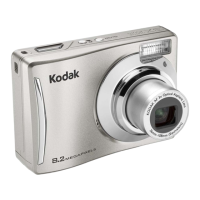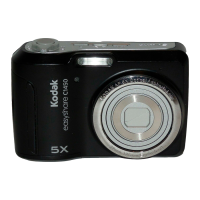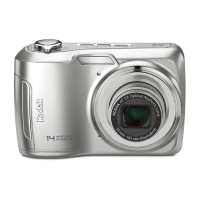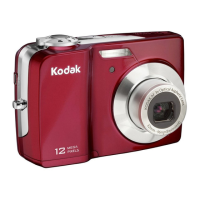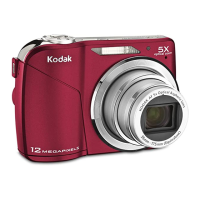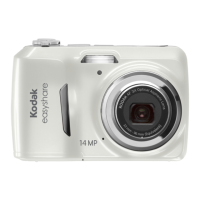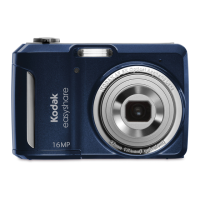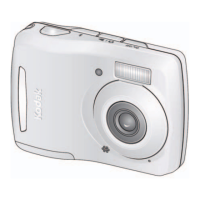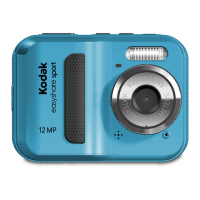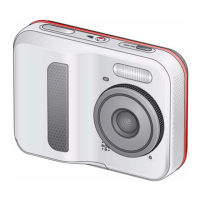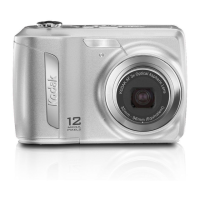
Do you have a question about the Kodak EasyShare C143 and is the answer not in the manual?
| Megapixel | 12.2 MP |
|---|---|
| Camera type | Compact camera |
| Sensor type | CCD |
| Image stabilizer | No |
| Image sensor size | 1/2.3 \ |
| Digital zoom | 5 x |
| Optical zoom | 3 x |
| Focal length range | - mm |
| Digital SLR | - |
| Video capability | Yes |
| Power supply type | AA |
| Dimensions (WxDxH) | 93.8 x 30.1 x 62 mm |
| Camera shutter speed | 8 - 1/1400 s |
| Compatible operating systems | Windows OS, MAC OS. |
| Focal length (35mm film equivalent) | 32 - 96 mm |
| Focus adjustment | Auto |
| Auto focusing (AF) modes | Centre weighted Auto Focus, Multi Point Auto Focus |
| Macro focusing range (tele) | 0.35 - 1 m |
| Macro focusing range (wide) | 0.1 - 0.8 m |
| Flash modes | Auto, Fill-in, Flash off, Red-eye reduction |
| Flash range (tele) | 0.5 - 2 m |
| Flash range (wide) | 0.3 - 4 m |
| Internal memory | 32 MB |
| Compatible memory cards | SD, SDHC |
| Motion JPEG frame rate | 30 fps |
| Video formats supported | AVI |
| Maximum video resolution | 640 x 480 pixels |
| Display diagonal | 2.7 \ |
| Display resolution (numeric) | 230000 pixels |
| USB version | 2.0 |
| Scene modes | Panorama |
| Photo effects | Black&White, Neutral |
| White balance | Auto, Daylight, Fluorescent, Shade, Tungsten |
| Self-timer delay | 10 s |
| Product color | Silver |
| Battery technology | Alkaline |
| Operating temperature (T-T) | 0 - 40 °C |
| Depth | 30.1 mm |
|---|---|
| Width | 93.8 mm |
| Height | 62 mm |
| Weight | 172 g |
Visual guide to buttons, ports, and lenses on the camera body.
Instructions for inserting and using an optional SD or SDHC card for storage.
Steps for inserting batteries, turning the camera on, and setting basic preferences.
How to configure the camera's language, date, and time settings.
How to take still pictures and record videos using the camera's basic functions.
Accessing and viewing captured images and video clips on the camera's LCD.
Guide to installing Kodak software and transferring photos/videos to a computer.
Explanation of various shooting modes like Smart Capture, Program, and Scene.
Methods for tagging photos with keywords, people, or favorites.
Guide to selecting and using different flash modes for optimal lighting.
How to use the camera's built-in help system for assistance.
Labels and functions of buttons and features on the front of the camera.
Labels and functions of buttons, ports, and the LCD screen on the back.
Instructions on how to securely attach the camera's wrist strap.
Step-by-step guide for correctly inserting AA batteries into the camera.
Procedure for powering on the camera and initial startup steps.
How to configure the camera's language, date, and time settings.
Instructions for inserting and utilizing optional SD or SDHC memory cards.
How to compose and capture a photograph using the shutter button.
Explanation of how framing marks indicate the camera's focus area.
Steps for selecting video mode and capturing video footage.
How to immediately view or delete the last captured picture or video.
A guide to interpreting icons displayed during picture capture.
How to check the camera's battery status using the on-screen indicator.
How to use the zoom lever to adjust focal length for framing shots.
Information on extending magnification beyond optical zoom, with quality considerations.
How to cycle through and choose different flash modes like Auto, Fill, and Red-Eye Reduction.
Guide to selecting modes like Smart Capture, Program, Scene, and Video for different shooting scenarios.
Explanations for various Scene modes (Portrait, Sport, Sunset, etc.) and their best uses.
How to use the Info button to access and navigate shortcuts for common functions.
How to set the self-timer for delayed picture taking, including timer options.
How to capture multiple photos in rapid succession using burst mode.
Instructions on how to 'stitch' multiple photos together to create a panoramic image.
Steps for selecting photos and sharing them directly to social networking sites.
How to choose which social networking sites appear on the camera.
Adding, editing, or deleting email addresses and KODAK PULSE Digital Frames.
How to tag photos with names to help the camera recognize people.
How to modify existing people tags or add new names.
How to add keywords to pictures for easier searching and organization.
Instructions for entering text using the camera's keyboard interface.
How to mark photos for email transfer, including managing email addresses.
How to browse captured media using the Review button and navigation controls.
How to delete unwanted files, use the undo feature, and protect files from deletion.
Options for zooming in on photos and viewing multiple thumbnails simultaneously.
Using tabs like All, Date, People, and Keywords to locate specific pictures.
Identifying icons related to print count, protection status, and email marking.
How the battery level indicator functions and when it appears.
Steps to create a slide show and set it to loop continuously.
How to connect the camera to a TV or monitor using an A/V cable.
Navigating menus (Review, Edit, Setup) while viewing photos.
How to trim unwanted parts from a picture, saving the original.
Changing the orientation of a picture to portrait or landscape.
Extracting a still image from a video clip.
Removing unwanted start or end portions from a video file.
Using multi-select for batch operations like printing or deleting.
Transferring media between internal memory and an SD card.
Accessing and modifying various camera settings using the Menu button.
Adjusting settings like Picture Size and Self-timer/Burst within the Capture tab.
Modifying Exposure Compensation, ISO Speed, Color Mode, and White Balance.
Setting focus distance, zone assessment, and auto-focus behavior.
Adjusting video options and self-timer features.
Setting date/time, managing camera sounds, and keyword tags.
Customizing LCD brightness and defining Share button behavior.
Configuring red-eye reduction and regional video output settings.
Managing storage location and camera language preferences.
Procedures for formatting storage media and understanding associated cautions.
Accessing KODAK Software download links and camera information.
Guide to obtaining and installing the necessary software for transferring media.
Connecting the camera to a KODAK printer for direct photo printing.
Information on ordering prints and photo products online via KODAK Gallery.
How to print photos directly from memory cards using compatible printers or kiosks.
How to set the desired number of copies for photos before printing.
Instructions on how to activate and navigate the camera's on-board help feature.
Solutions for issues like the camera not turning on or buttons not functioning.
Fixes for screen display errors and flash not firing.
Steps to fix problems when the computer does not communicate with the camera.
Solutions for issues encountered when printing directly via PICTBRIDGE.
Tips for achieving sharp focus and clear images, including lens cleaning.
Solutions for pictures that are too dark or too light, including lighting and exposure compensation adjustments.
Links to Kodak's website for FAQs, troubleshooting, and product support.
Overview of sensor, LCD, storage, lens, zoom, and focus system details.
Information on modes, file formats, picture sizes, video capture, and computer communication.
Guidelines for cleaning the camera and handling potential water damage.
Instructions on how to check for and install the latest camera software and firmware.
How the camera displays remaining storage space and factors affecting capacity.
Critical safety warnings regarding product disassembly, accessories, and liquids.
Information on battery types, replacement, and factors affecting battery life.
Explanation of what the limited warranty covers, including repair or replacement.
Details on warranty limitations, disclaimers, and consumer rights.
Information regarding FCC regulations and potential radio frequency interference.
Guidelines for disposing of electronic waste and compliance with Canadian standards.
Declarations of compliance with various international electronic device regulations.
Information on hazardous substance content (RoHS) and Korean Class B ITE compliance.
Essential safety guidelines for operating the camera, accessories, and in specific environments.
Critical instructions for safe battery use, handling, and disposal.
Warnings and instructions for using the camera's battery charger safely.
